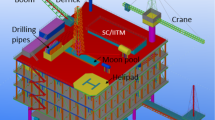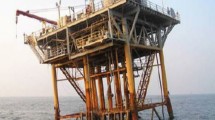Abstract
This study investigates the behavior of the topside of an offshore platform under hydrocarbon explosion and wind. Topside is designed for a combination of loads arising from types of equipment, fixed and rotating machinery, and cranes, apart from the gravity loads. While the wind loads are calculated using a gust factor and applied at different levels of the deck, a preliminary analysis is carried out using SAP2000 nonlinear. The design check carried following the code confirmed that the chosen sections satisfy the design requirements, both in strength and serviceability criteria. The topside of a typical offshore platform is highly vulnerable to fire and hydrocarbon explosion, causing extreme pressure and temperature in the confined areas. Pressure caused by the hydrocarbon explosion is rapid and results in an impulsive force of short duration. It damages the structural components and affects the overall performance of the topside considerably. The blast load is applied as an overpressure on the beams and columns and analyzed using ABAQUS explicit. The current study investigates the structural adequacy of members, constructed with X52 steel and functionally graded material (FGM). A comparison of the results showed that FGM offers more resistance to the displacement of beams and columns. Under the action of blast overpressure, members with FGM showed a significant reduction in both the plastic stain and Von-Mises stress at the beam–column connections in comparison with that of X52 steel.



























Similar content being viewed by others
References
Chandrasekaran S (2014) Advanced theory on offshore plant FEED engineering. Changwon National University Press, Changwon, p 237. ISBN 978-89-969-7928-9
Chandrasekaran S (2015) Advanced marine structures. CRC Press, Florida. ISBN 978-14-987-3968-9
Chandrasekaran S, Bhattacharyya SK (2012) Analysis and design of offshore structures with illustrated examples. Human Resource Development Center for Offshore and Plant Engineering (HOPE Center), Changwon National University Press, Changwon, p 285. ISBN 978-89-963-9155-5
Chandrasekaran S, Nagavinothini R (2020) Offshore compliant platforms: analysis, design and experimental studies. Wiley, Hoboken. ISBN 978-1-119-66977-7
Chandrasekaran S (2019) Advanced steel design of structures. CRC Press, Florida. ISBN 978-036-72-3290-0
Chandrasekaran S, Nagavinothini R (2019) Tether analyses of offshore triceratops under ice loads due to continuous crushing. Int J Innovat Infrastruct Solut 4:25. https://doi.org/10.1007/s41062-019-0212-5
Nagavinothini R, Chandrasekaran S (2019) Dynamic analyses of offshore triceratops in ultra-deep waters under wind, wave, and current. Structures 20:279–289. https://doi.org/10.1016/j.istruc.2019.04.009
Kishi N, Chen WF, Goto Y, Matsuoka KG (1993) Design aid of semi-rigid connections for frame analysis. Eng J 30(3):90–107
Kulkarni RB, Patil VA (2011) Design aids of flexural members and beam-columns based on limit state method. Int J Sci Eng Res, Vol 2, Issue 10, ISSN 2229-5518
Torkamani MA, Sonmez M, Cao J (1997) Second-order elastic plane-frame analysis using the finite-element method. J Struct Eng 123(9):1225–1235
Ngo-Huu C, Kim SE, Oh JR (2007) Nonlinear analysis of space steel frames using fiber plastic hinge concept. Eng Struct 29(4):649–657
Azizinamini A, Bradburn JH, Radziminski JB (1987) Initial stiffness of semi-rigid steel beam-to-column connections. J Constr Steel Res 8:71–90
Lee SS, Moon TS (2002) Moment–rotation model of semi-rigid connections with angles. Eng Struct 24(2):227–237
Garlock ME, Quiel SE (2008) Plastic axial load and moment interaction curves for fire-exposed steel sections with thermal gradients. J Struct Eng 134(6):874–880
Vishnuraj K, Janardhanan S, Sandeep TN (2018) Design optimization of water injection module of topside facility of an FPSO. Int J Struct Mech Finite Elements 4(1):1–14
Henriksen LO (2008) Structural design and analysis of FPSO topside module supports. In: Annual meeting and expo. Society of naval architects and marine engineers
Ocel J, DesRoches R, Leon RT, Hess WG, Krumme R, Hayes JR, Sweeney S (2004) Steel beam-column connections using shape memory alloys. J Struct Eng 130(5):732–740
Chandrasekaran S, Hari S, Amirthalingam M (2019) Wire-arc additive manufacturing of functionally-graded material for marine riser applications. Proceedings of I-OCEANS 2019, Universiti Teknologi Malaysia, Terengganu, Malaysia, 5–7th Aug 2019
Srinivasan H (2020) Dynamic analysis of marine risers with functionally graded material, Ph. D Dissertation submitted to IIT Madras
Gardner L, Wang F, Liew A (2011) Influence of strain hardening on the behavior and design of steel structures. Int J Struct Stab Dyn 11(05):855–875
Naughton DT, Tsavdaridis KD, Maraveas C, Nicolaou A (2017) Pushover analysis of steel seismic-resistant Frames with reduced Web section and reduced Beam section connections. Front Built Environ 3:59
Wilkinson S, Hurdman G, Crowther A (2006) A moment-resisting connection for earthquake resistant structures. J Constr Steel Res 62(3):295–302
Chandrasekaran S, Srivastava G (2017) Design aids for offshore structures under special environmental loads, including fire resistance. Springer, Singapore. ISBN 978-981-10-7608-4
Chandrasekaran S, Nagavinothini R (2019) Parametric studies on the impact response of offshore triceratops in ultra-deep waters. Struct Infrastruct Eng. https://doi.org/10.1080/15732479.2019.1680707
Chandrasekaran S, Nagavinothini R (2019) Response of triceratops to impact forces: numerical investigations. Ocean Syst Eng J 9(4):349–368. https://doi.org/10.12989/ose.2019.9.4.349
Louca LA, Ali RM (2008) Improving the ductile behavior of offshore topside structures under extreme loads. Eng Struct 30(2):506–521
Sabuwala T, Linzell D, Krauthammer T (2005) Finite element analysis of steel beam to column connections subjected to blast loads. Int J Impact Eng 31(7):861–876
Schleyer GK, Campbell D (1996) Development of simplified analytical methods for predicting the response of offshore structures to blast and fire loading. Marine Struct 9(10):949–970
Krauthammer T (1999) Blast-resistant structural concrete and steel connections. Int J Impact Eng 22(9–10):887–910
Kang KY, Choi KH, Choi JW, Ryu YH, Lee JM (2017) Explosion induced dynamic responses of blast wall on FPSO topside: blast loading application methods. Int J Naval Architect Ocean Eng 9(2):135–148
Kang KY, Choi KH, Choi J, Ryu Y, Lee JM (2016) Dynamic response of structural models according to characteristics of a gas explosion on the topside platform. Ocean Eng 113:174–190
Louca LA, Pan YG, Harding JE (1998) Response of stiffened and unstiffened plates subjected to blast loading. Eng Struct 20(12):1079–1086
Chandrasekaran S, Nagavinothini R (2017) Analysis and design of offshore triceratops under ultra-deep waters. Int J Civil Environ Struct Constr Arch Eng 11(11):1520–1528
Author information
Authors and Affiliations
Corresponding author
Ethics declarations
Conflict of interest
Authors do not have any conflict of interest in the present study.
Rights and permissions
About this article
Cite this article
Chandrasekaran, S., Pachaiappan, S. Numerical analysis and preliminary design of topside of an offshore platform using FGM and X52 steel under special loads. Innov. Infrastruct. Solut. 5, 86 (2020). https://doi.org/10.1007/s41062-020-00337-4
Received:
Accepted:
Published:
DOI: https://doi.org/10.1007/s41062-020-00337-4




